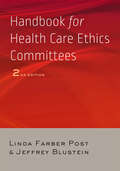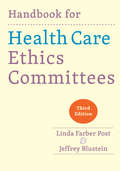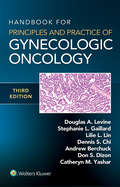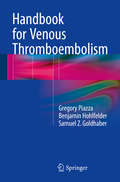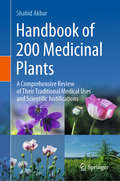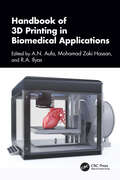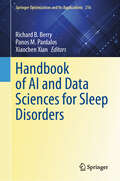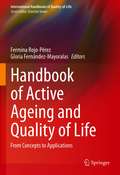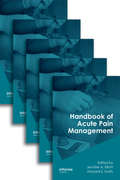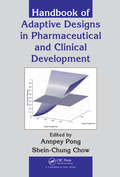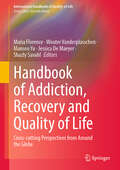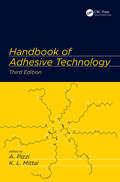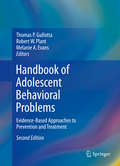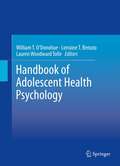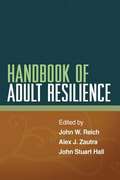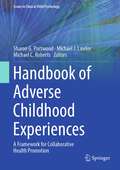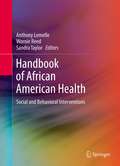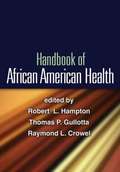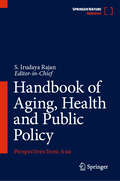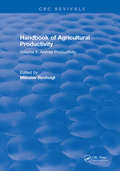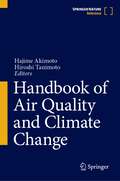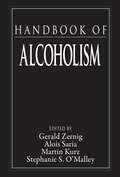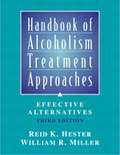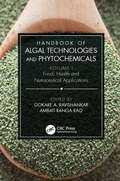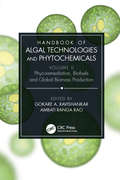- Table View
- List View
Handbook for Health Care Ethics Committees
by Jeffrey Blustein Linda Farber PostHow can dedicated ethics committees members fulfill their complex roles as moral analysts, policy reviewers, and clinical consultants?The Joint Commission (TJC) accredits and certifies more than 19,000 health care organizations in the United States, including hospitals, nursing homes, and home care agencies. Each organization must have a standing health care ethics committee to maintain its status. These interdisciplinary committees are composed of physicians, nurses, attorneys, ethicists, administrators, and interested citizens. Their main function is to review and provide resolutions for specific, individual patient care problems. Many of these committees are well meaning but may lack the information, experience, skills, and formal background in bioethics needed to adequately negotiate the complex ethical issues that arise in clinical and organizational settings.Handbook for Health Care Ethics Committees was the first book of its kind to address the myriad responsibilities faced by ethics committees, including education, case consultation, and policy development. Adopting an accessible tone and using a case study format, the authors explore serious issues involving informed consent and refusal, decision making and decisional capacity, truth telling, the end of life, palliative care, justice in and access to health care services, and organizational ethics.The authors have thoroughly updated the content and expanded their focus in the second edition to include ethics committees in other clinical settings, such as long-term care facilities, small community hospitals, rehabilitation centers, and hospices. They have added three new chapters that address reproduction, disability, and the special needs of the elder population, and they provide additional specialized policies and procedures on the book’s website. This guide is an essential resource for all health care ethics committee members.
Handbook for Health Care Ethics Committees
by Jeffrey Blustein Linda Farber PostHow can dedicated health care ethics committees increase their effectiveness and demonstrate their value as essential moral resources for their organizations?Among the most effective and increasingly valued resources in the health care decision-making process is the institutional ethics committee. The Joint Commission (TJC) accredits and certifies more than 19,000 health care organizations in the United States, including hospitals, nursing homes, and home care agencies. As a condition of accreditation, TJC requires health care organizations to have available a standing multidisciplinary ethics committee, composed of physicians, nurses, attorneys, ethicists, administrators, and interested lay citizens. Many of these committees are well meaning but may lack the information, experience, skills, and formal background in bioethics needed to effectively address the range and complexity of the ethical issues that arise in clinical and organizational settings.Handbook for Health Care Ethics Committees was conceived in 2007 to address the myriad responsibilities assumed by ethics committees. Using sample cases and accessible language, Linda Farber Post and Jeffrey Blustein explored applied bioethics, including informed consent and refusal, decision making and decisional capacity, truth telling, care at the beginning and end of life, palliation, justice in and access to health care services, and organizational ethics.In the third edition, Post and Blustein have thoroughly updated and reorganized the content and expanded the scope of the material, with special attention to changes in the health care landscape since the second edition was published in 2015. They also focus on communication between and among patients, care providers, and families, the demands of professionalism, the essential role that ethics committees can and should play, and how their effectiveness and value can be assessed. An entirely new chapter examines research ethics. The book also addresses the challenging ethical issues raised by the ongoing COVID-19 pandemic. This guide remains an essential resource for all health care ethics committee and their members.
Handbook for Principles and Practice of Gynecologic Oncology
by Douglas A. Levine Lillie Lin Stephanie GaillardSized to fit in your pocket for quick reference, Handbook for Principles and Practice of Gynecologic Oncology, 3rd Edition, is packed with the essential information you need on the diagnosis and management of gynecologic cancers. Now in full color for the first time, this bestselling handbook features coverage of the most recent developments in the field, clear and concise data that support treatment recommendations, and numerous algorithms and tables throughout. Fellows, residents, and specialist trainees will benefit from authoritative coverage in an easily accessible format.
Handbook for Venous Thromboembolism
by Gregory Piazza Benjamin Hohlfelder Samuel Z. GoldhaberThis book has been developed over numerous iterations within the Brigham and Women's Hospital to provide the most critical information for trainees and physicians, and thus it represents a truly practical guidebook for anyone who needs the key information on the diagnosis, management and prevention of venous thromboembolism. Specific areas of focus include understanding the risk factors for VTE and the role of the right ventricle in PE pathophysiology. Efficient algorithms for diagnosis and exclusion of DVT and PE are emphasized. An state-of-the-art review of current techniques for the management of high risk VTE, including submassive and massive PE, is presented. The novel oral anticoagulants are revolutionizing the way VTE is treated and are covered in detail.
Handbook of 200 Medicinal Plants: A Comprehensive Review of Their Traditional Medical Uses and Scientific Justifications
by Shahid AkbarThis book is designed to provide pharmacologists and researchers of natural products a comprehensive review of 200 medicinal plants, their vernacular names in various languages and their medicinal uses around the world, and in some cases, a historical perspective. Chemical constituents of each plant with the putative active constituent, and available up to date pharmacological studies (until 2017 on PubMed) with each medical activity explored and its relationship with traditional uses, are described for each plant. Any variations in chemical constituents and their effects on pharmacological studies outcome have been highlighted. All clinical trials conducted, with sufficient details, have been included. Nationalities and racial identities of participants of clinical trials are identified to impress upon the social, cultural and dietary influences on the clinical outcomes. Toxicity studies and potential interactions with prescribed drugs, and full spectrum of references are included.
Handbook of 3D Printing in Biomedical Applications
by R. A. Ilyas A. N. Aufa Mohamad Zaki Hassan3D printing is a promising fabrication technique capable of creating objects with precise structures and shapes based on 3D model data, allowing for versatile alterations and production of intricate shapes while also reducing the consumption of feedstock, particularly crucial in the cost-sensitive realm of medicine. In the biomedical sphere the use of 3D printing spans various applications, from artificial organs to sensors and orthopedic implants. This handbook explores the transformative role of technology in healthcare, focusing on materials, design, and innovation. It covers diverse applications like prosthetics, devices, tissue engineering, and medicine. This comprehensive resource highlights cutting-edge advancements, ethical considerations, and future trends, offering insights for researchers, professionals, and students. Explores the latest advances, technologies, and practical applications of additive manufacturing in biomedical engineering, including its impact on tissue engineering, drug delivery systems, regenerative medicine, and orthodontics Covers polymer 3D bioprinting techniques and advanced materials pivotal for successful biomedical implants in clinical settings Discusses the integration of smart materials and their applications including point-of-care solutions Encompasses various facets of medical technology, including diagnostic instruments, therapeutic devices, tissue engineering, and regenerative medicine Examines both in vivo and in vitro studies related to 3D printing, unraveling their significance and implications in various contexts Considers challenges and future perspectives With its comprehensive approach, this handbook serves as the definitive resource for researchers, practitioners, and advanced students, fostering a deeper appreciation and understanding of the transformative power of 3D printing in shaping the future of biomedical engineering.
Handbook of AI and Data Sciences for Sleep Disorders (Springer Optimization and Its Applications #216)
by Panos M. Pardalos Richard B. Berry Xiaochen XianThe rise of lifestyle changes resulting from constant connectivity, irregular work schedules, heightened stress, and disruptive sleep patterns, have contributed to increasing insomnia rates. Exacerbated by the COVID-19 pandemic, sleep disorders are more prevalent than ever. This handbook offers a comprehensive exploration of the fusion of Artificial Intelligence (AI) and data science within the realm of sleep disorders, presenting innovative approaches to diagnosis, treatment, and personalized care. The interdisciplinary nature of this handbook fosters collaboration between experts from diverse fields, including computer science, engineering, neuroscience, medicine, public health, AI, data science, and sleep medicine. Each chapter delves into specific aspects of sleep disorder analysis, innovative methodologies, novel insights, and real-world applications that showcase the transformative potential of AI and data science in sleep medicine, from analyzing sleep patterns and predicting disorder risk factors to utilizing big data analytics for large-scale epidemiological studies. This handbook hopes to offer a comprehensive resource for researchers, clinicians, and policymakers striving to address the challenges in sleep medicine.
Handbook of Active Ageing and Quality of Life: From Concepts to Applications (International Handbooks of Quality-of-Life)
by Fermina Rojo-Pérez Gloria Fernández-MayoralasThis handbook presents an overview of studies on the relationship of active ageing and quality of life. It addresses the new challenges of ageing from the paradigm of positive ageing (active, healthy and successful) for a better quality of life. It provides theoretical perspectives and empirical studies, including scientific knowledge as well as practical experiences about the good ageing and the quality of later life around the world, in order to respond to the challenges of an aged population. The handbook is structured in 4 sections covering theoretical and conceptual perspectives, social policy issues and research agenda, methods, measurement instrument-scales and evaluations, and lastly application studies including domains and geographical contexts. Chapter 5 is available open access under a Creative Commons Attribution 4.0 International License via link.springer.com.
Handbook of Acute Pain Management
by Howard S. Smith Jennifer A. ElliottPain is a pervasive symptom present in multiple areas of medicine. It is imperative that physicians not only evaluate and diagnose the source of pain, but that they also recognize how to manage the actual pain symptoms with effective treatment. Handbook of Acute Pain Management is an essential reference for professionals to enhance their knowledge
Handbook of Adaptive Designs in Pharmaceutical and Clinical Development
by Shein-Chung Chow Annpey PongIn response to the US FDA's Critical Path Initiative, innovative adaptive designs are being used more and more in clinical trials due to their flexibility and efficiency, especially during early phase development. Handbook of Adaptive Designs in Pharmaceutical and Clinical Development provides a comprehensive and unified presentation of the princip
Handbook of Addiction, Recovery and Quality of Life: Cross-cutting Perspectives from Around the Globe (International Handbooks of Quality-of-Life)
by Maria Florence Wouter Vanderplasschen Mansoo Yu Jessica De Maeyer Shazly SavahlThis handbook brings together research and innovation across two important and related fields, quality of life (QoL) and addiction recovery. Though both fields of research are equally vibrant, this volume brings together the advancing scholarly exploration of the intersection between QoL and addiction recovery. It provides comprehensive coverage of the theoretical perspectives on QoL in the field of addiction and recovery; instruments and methodologies to assess QoL; different types of addiction in specific populations and QoL; and practices and interventions for supporting recovery and promoting QoL. It importantly includes international and intercultural perspectives on QoL and addiction recovery. By including sound theoretical, conceptual, historical, empirical and cross-cultural contributions on QoL and addictions, the volume offers many opportunities for advancing support, treatment and recovery of persons with addiction problems based on their subjective perspectives and experiences. This handbook is a go-to resource for a wide interdisciplinary readership interested in quality-of-life research, subjective well-being, public health, and addiction research.
Handbook of Adhesive Technology
by Antonio Pizzi Kashmiri L. MittalThis classic reference examines the mechanisms driving adhesion, categories of adhesives, techniques for bond formation and evaluation, and major industrial applications. Integrating recent innovation and improved instrumentation, the work offers broad and comprehensive coverage. This edition incorporates several new adhesive classes, new application topics, and recent developments with nanoadhesives and bio-based adhesives. Existing chapters are thoroughly updated, revised, or replaced and authored by top specialists in the field. Abundant figures, tables, and equations appear throughout the work.
Handbook of Adolescent Behavioral Problems
by Thomas P. Gullotta Robert W. Plant Melanie A. EvansThe Second Edition of the Handbook of Adolescent Behavioral Problems clarifies the current state of treatment and prevention through comprehensive examinations of mental disorders and dysfunctional behaviors as well as the varied forces affecting their development. New or revised chapters offer a basic framework for approaching mental health concerns in youth and provide the latest information on how conditions (e. g. , bipolar disorder, suicidality, and OCD) and behaviors (e. g. , sex offenses, gang activities, dating violence, and self-harm) manifest in adolescents. Each chapter offers diagnostic guidance, up-to-date findings on prevalence, biological/genetic aspects, risk and resilience factors, and a practical review of prevention and treatment methods. Best-practice recommendations clearly differentiate among what works, what might work, what doesn't work, and what needs further research across modalities, including pharmacotherapy. Key topics addressed include: Families and adolescent development. Adolescent mental health and the DSM-5. Oppositional Defiant Disorder and Conduct Disorder. Autism spectrum disorder. Media and technology addiction. School failure versus school success. Bullying and cyberbullying. The Second Edition of the Handbook of Adolescent Behavior Problems is a must-have reference for researchers, clinicians, allied practitioners and professionals, and graduate students in school and clinical child psychology, education, pediatrics, psychiatry, social work, school counseling, and public health.
Handbook of Adolescent Health Psychology
by William T. O'Donohue Lauren Woodward Tolle Lorraine T. BenutoAdolescence is a pivotal period of development with respect to health and illness. It is during adolescence that many positive health behaviors are consolidated and important health risk behaviors are first evident; thus, adolescence is a logical time period for primary prevention. In addition, the predominant causes of morbidity and mortality in adolescence are quite different from those of adults, indicating that early identification and treatment of adolescent health problems must be directed to a unique set of targets in this age group. Moreover, because of the particular developmental issues that characterize adolescence, intervention efforts designed for adults are often inappropriate or ineffective in an adolescent population. Even when chronic illnesses are congenital or begin in childhood, the manner in which the transition from childhood to adolescence to young adulthood is negotiated has important implications for disease outcomes throughout the remainder of the person's life span. Organized in five major sections (General Issues, Developmental Issues, Treatment and Training, Mental Health, and Physical Health) and 44 chapters, Handbook of Adolescent Health Psychology addresses the common and not so common health issues that tend to affect adolescents. Coverage includes: Context and perspectives in adolescent health psychology Health literacy, health maintenance, and disease prevention in adolescence Physical disorders such as asthma, obesity, physical injury, and chronic pain Psychological disorders such as substance abuse, attention deficit hyperactivity disorder, depression, and eating disorders Congenital chronic diseases such as type 1 diabetes and spina bifida Handbook of Adolescent Health Psychology is the definitive reference for pediatricians, family physicians, health psychologists, clinical social workers, rehabilitation specialists, and all practitioners and researchers working with adolescents.
Handbook of Adult Resilience
by John Reich Alex ZautraThe first book to move beyond childhood and adolescence to explore processes of resilience across the lifespan, this cutting-edge volume synthesizes the best current research in the field. Contributors offer a comprehensive examination of resilience at multiple levels of analysis, from genetic and physiological factors through individual, family, and community processes. Compelling topics include Whether resilience is best understood as a trait, a dynamic developmental process, an outcome, or all of the above. How resilience intersects with health and well-being across the adult life cycle. Cross-cultural issues in conceptualization and measurement. Ways to enhance adult resilience, including reviews of exemplary programs.
Handbook of Adverse Childhood Experiences: A Framework for Collaborative Health Promotion (Issues in Clinical Child Psychology)
by Michael C. Roberts Sharon G. Portwood Michael J. LawlerThis handbook explores ways to unify the study and application of adverse childhood experiences (ACEs) across multiple fields and disciplines, including clinical child and adolescent psychology, school psychology, pediatrics, social work, public health, education, and other health and human services. The book outlines a cohesive framework that organizes critical ACEs concepts throughout individual chapters, highlighting key issues and themes across settings and disciplines as well as gaps in current knowledge. Chapters examine interdisciplinary and collaborative approaches to ACEs and their impact on health and well-being within a specific topic area or setting. In addition, chapters review the foundations and development of the relevant science and provide examples of ACEs research and intervention applications as well as suggestions for continued advancement in this field. Key areas of coverage include: Definition and measurement of ACEs. Theory and models guiding ACEs research and practice. Applications of ACEs science across settings, including healthcare, mental and behavioral health, schools, justice system, and child welfare system. Applications of ACEs to public health and policy issues. Prevention strategies and policy approaches to ACEs. Handbook of Adverse Childhood Experiences is an essential resource for researchers, professors, and graduate students as well as clinicians and related mental health and medical therapists and professionals in developmental and clinical child and adolescent psychology, school psychology, child and adolescent psychiatry, social work, child and family studies, public health, pediatrics, and all interrelated disciplines.
Handbook of African American Health
by Sandra Taylor Wornie Reed Anthony J. LemelleThe U.S. Census Bureau reports particular demographic, social, and health conditions for African Americans. Population-wide, the African American community has a higher mortality rate from cancer and diabetes than the rest of the population, a higher infant mortality rate, and a lower vaccination rate for influenza and pneumonia. The contributions to this comprehensive Handbook of African American Health uncover the specific demographic conditions of the African American population, and outline social interventions for both physical and mental health at the primary, secondary, and tertiary levels. The 26 contributions to this comprehensive volume cover interventions for a diverse range of health problems, including: -obesity and cardiovascular disease -diabetes -asthma and other respiratory diseases -smoking, alcohol, and recreational drug abuse -risky sexual behaviors -cancer screening, prevention, and survivorship -infant mortality -community and interpersonal violence -mental health From a healthcare standpoint, it also examines specific interventions for treatment compliance, health care access, and community collaborations. This volume will be an invaluable resource for researchers in medical sociology, mental health studies, public health, health behavior, and African American studies.
Handbook of African American Health
by Thomas Gullotta Robert HamptonWith a focus on how to improve the effectiveness and cultural competence of clinical services and research, this authoritative volume synthesizes current knowledge on both the physical and psychological health of African Americans today. In chapters that follow a consistent format for easy reference, leading scholars from a broad range of disciplines review risk and protective factors for specific health conditions and identify what works, what doesn't work, and what might work (i.e., practices requiring further research) in clinical practice with African Americans. Historical, sociocultural, and economic factors that affect the quality and utilization of health care services in African American communities are examined in depth. Evidence-based ways to draw on individual, family, and community strengths in prevention and treatment are highlighted throughout.
Handbook of Aging, Health and Public Policy: Perspectives from Asia
by S. Irudaya RajanThis handbook presents the latest information on all aspects of global aging, with a focus on Asia, including policies, age-associated diseases and conditions, health services, long-term care, living arrangements, income and social security, preventing abuse, and the impact of migration on the elderly. Furthermore, the book presents a synthesis of research on population aging, social protection policies, crimes against the elderly, new analyses of trends, and discussions of major social policy strategies. Written by academics, practitioners and policymakers in the field of gerontology, the book offers an informative resource for demographers, gerontologists, economists, anthropologists and other social scientists studying various facets of aging, as well as students in the social and health sciences.
Handbook of Agricultural Productivity: Volume II: Animal Productivity (Crc Series In Nutrition And Food)
by Miloslav RechciglThe greatest challenge of our time is to produce sufficient food ot keep pace with the rapidly growing population. In the opinion of experts, during the next 25 years there will be a need for as much food as was produced in the entire history of mankind to date. Of the various measures available, improvement in agricultural productivity is judged as the ultimate means of augmenting food production and supplies. In this Handbook, an international team of experts consider the most important factors affecting production of both crops and livestock. This Handbook is intended as a scientific guide to practitioners and students, as well as to researchers, who should find here stimulating ideas for further exploration.
Handbook of Air Quality and Climate Change
by Hajime Akimoto Hiroshi TanimotoThis handbook covers the air quality/air pollution from the viewpoints of causing impacts on human/ecosystem health and climate change. Traditionally, air pollution has been a concern mainly in terms of its impacts on human health, and it is still an immediate public and governmental concern in most Asian countries. However, in recent years so-called extreme weather events, such as stronger tropical cyclones, flooding, drought, and other phenomena, have been manifested causing tremendous losses of human lives and properties. Importantly, climate models tell us that such extreme weather events are actually induced by anthropogenic global warming. It has been pointed out that mitigation or alleviation of such climate change leading to the extreme weather events in the next 30 years can be possible only by reducing air pollutants with positive radiative forcing such as ozone or methane, which are called short-lived climate pollutants (SLCPs). Here, concerns about mitigation of air pollutants from the points of human health and climate change have merged. This book covers different kinds of air pollutants and radiative forcers and how they can be measured. It also mentions the situation of air pollutants in different continents and their regional impacts to human health, environment and economy as well as their link to extreme weather events. The book presents how the air pollution and climate change can be mitigated and how clean air technologies and international initiatives for co-controlling air pollution and climate change have been developed.
Handbook of Alcoholism (Handbooks in Pharmacology and Toxicology)
by Gerald Zernig Alois Saria Martin Kurz Stephanie S. O’MalleyWhile the war on drugs continues to attract world attention, it is often overlooked that alcoholism remains a major worldwide health concern. No matter what your expertise, the CRC Handbook of Alcoholism can help you acquire the necessary skills to treat problem drinkers and alcohol-dependent patients.In three sections - Patient Care, Research,
Handbook of Alcoholism Treatment Approaches: Effective Alternatives, Third Edition
by William R. Miller Reid K. HesterThe Handbook of Alcoholism Treatment Approaches is a comprehensive, results-based guide to alcohol treatment methods. This handbook surveys the various models that have been used to define alcoholism, ending with a discussion of what the authors call "an informed eclecticism. " Using this approach, clinicians develop a spectrum of treatment approaches that have proved effective in practice, then match specific clients with the treatment methods that offer the greatest opportunities for success in these specific circumstances. This new edition of this handy reference provides both practitioners and researchers with a rich source of information on treatment interventions demonstrated to be the most successful. Clinical Psychologists and Alcohol Treatment Specialists.
Handbook of Algal Technologies and Phytochemicals: Volume I Food, Health and Nutraceutical Applications
by Gokare A. Ravishankar Ambati Ranga RaoKey features: The most comprehensive resource available on the biodiversity of algal species, their industrial production processes and their use for human consumption in food, health and varied applications. Emphasis on basic and applied research, addressing aspects of scale-up for commercial exploitation for the development of novel phytochemicals (phytochemicals from algae). Addresses the underexplored and underutilized potential of chemicals from marine sources for health benefits. Each chapter, written by expert contributors from around the world, includes Summary Points, Figures and Tables, as well as up-to-date references. The first book in this two-volume set explores the diversity of algal constituents for health and disease applications. The commercial value of chemicals of value to food and health is about $6 billion annually, of which 30 percent relates to micro and macro algal metabolites and products for health food applications. This comprenhensive volume looks in detail at algal genomics and metabolomics as well as mass production of microalgae. As a whole, the two-volume set covers all micro and macro algal forms and their traditional uses; their constituents which are of value for food, feed, specialty chemicals, bioactive compounds for novel applications, and bioenergy molecules. Bio-business and the market share of algae-based products are also dealt with, providing global perspectives.
Handbook of Algal Technologies and Phytochemicals: Volume II Phycoremediation, Biofuels and Global Biomass Production
by Gokare A. Ravishankar Ambati Ranga RaoKey Features The most comprehensive resource available on the biodiversity of algal species, their industrial production processes and their use for human consumption in food, health and varied applications. Emphasis on basic and applied research, addressing aspects of scale-up for commercial exploitation for the development of novel phytochemicals (phytochemicals from algae). Addresses the underexplored and underutilized potential of chemicals from marine sources for health benefits. Each chapter, written by expert contributors from around the world, includes a Dictionary of Terms, Key Facts, Summary Points, Figures and Tables, as well as up-to-date references. The second book in this two-volume set explores phycoremedation applications, and the sustainable use of algae for biofuels and other products of economic value. It also looks at aspects such as macro- and micro algal impact on marine ecosystem and remote sensing of algal blooms. The commercial value of chemicals of value to food and health is about $6 billion annually, of which 30 percent relates to micro and macro algal metabolites and products for health food applications. As a whole, the two volumes explore the aspects of diversity of micro and macro algal forms, their traditional uses; their constituents which are of value for food, feed, specialty chemicals, bioactive compounds for novel applications, and bioenergy molecules. Bio-business and the market share of algae-based products are also dealt with, providing global perspectives.
